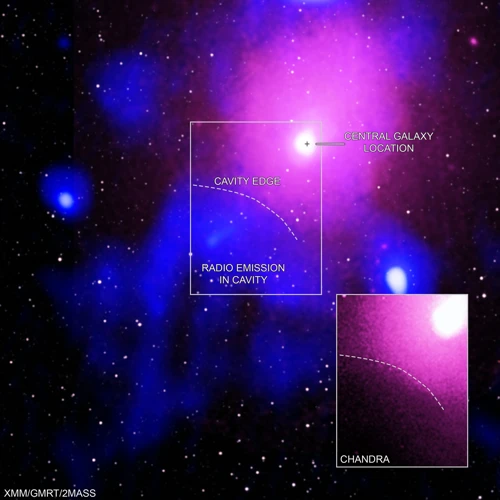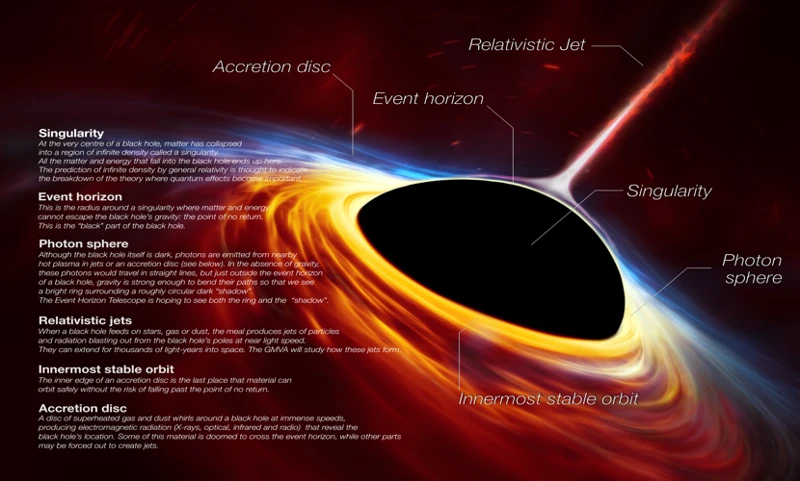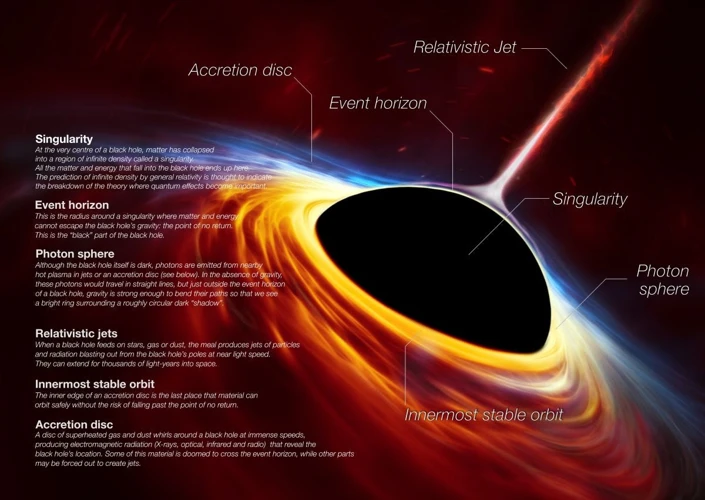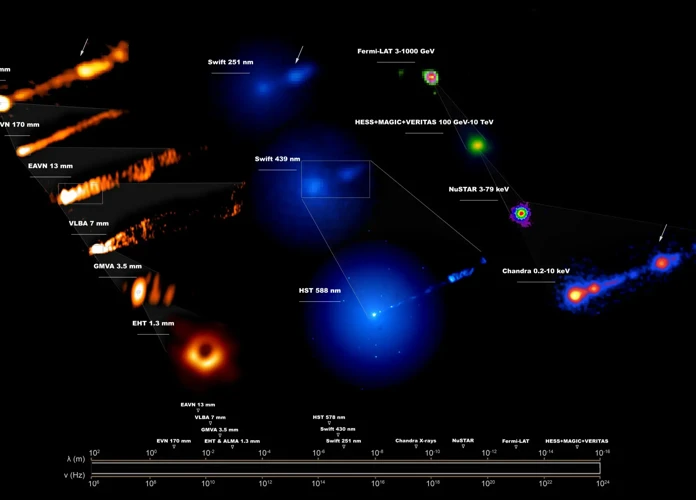Black holes have long captivated the curiosity of scientists and the imagination of the masses. These enigmatic cosmic entities possess such immense gravitational pull that nothing, not even light, can escape their grasp. While the concept of black holes may seem fantastical, the study of their electromagnetic radiation provides a glimpse into their mysterious nature. From X-rays to gamma rays, exploring the various wavelengths of radiation emitted by black holes sheds light on their inner workings and allows scientists to unlock the secrets of these celestial giants. In this article, we will delve into the world of black hole electromagnetic radiation, uncovering the intricacies of the electromagnetic spectrum and the different types of radiation emitted by these cosmic phenomena. We will also explore how X-rays and gamma rays enable us to study black holes in greater detail, revealing insights into their physics and behavior. So fasten your seatbelts and prepare for a journey into the depths of black hole electromagnetic radiation.
Contents
- 1. What are Black Holes?
- 2. Electromagnetic Radiation
- 3. Black Holes and X-rays
- 4. Black Holes and Gamma Rays
- 5. Studying Black Holes through Electromagnetic Radiation
- Conclusion
-
Frequently Asked Questions
- 1. What happens if you fall into a black hole?
- 2. Can black holes die?
- 3. Can we see black holes?
- 4. How big can a black hole get?
- 5. Are there different types of black holes?
- 6. Can black holes merge?
- 7. Can anything escape a black hole?
- 8. How do black holes form?
- 9. Can black holes move?
- 10. How do we detect black holes?
- References
-
Frequently Asked Questions
- 1. How is electromagnetic radiation related to black holes?
- 2. What is the electromagnetic spectrum?
- 3. How are X-rays used to probe black holes?
- 4. What are X-ray telescopes used for?
- 5. What are gamma rays, and how are they associated with black holes?
- 6. What are gamma-ray observatories used for?
- 7. What are the challenges in studying black holes through electromagnetic radiation?
- 8. What techniques are used to study black holes through electromagnetic radiation?
- 9. How does studying black holes through electromagnetic radiation provide insights into their physics?
- 10. How does exploring black hole electromagnetic radiation contribute to our overall understanding of the universe?
- References
- Read More
1. What are Black Holes?

A black hole is a region in space where gravity is so intense that nothing can escape its gravitational pull, not even light itself. These enigmatic cosmic entities form when a massive star collapses under the weight of its own gravity, resulting in an incredibly dense and compact object. The gravitational force at the core of a black hole is so powerful that it warps both space and time, creating a phenomenon known as a singularity. This singularity is surrounded by an event horizon, which marks the point of no return, beyond which anything that enters can never escape. The concept of black holes was first theorized in the early 20th century by Albert Einstein’s theory of general relativity. Since then, numerous observations and scientific studies have provided compelling evidence for their existence. Black holes play a crucial role in shaping the universe, influencing the formation of galaxies and even affecting the movement of stars within them. Understanding the nature of black holes is a topic of great importance in astrophysics, as it allows us to unravel the mysteries of the cosmos and gain insights into the fundamental laws of the universe. So, let’s embark on an intriguing journey as we unravel the secrets surrounding these cosmic enigmas.
2. Electromagnetic Radiation

Electromagnetic radiation is a fundamental aspect of the universe that encompasses a wide range of wavelengths, from radio waves to gamma rays. It is the energy transmitted through space in the form of electromagnetic waves, which consist of electric and magnetic fields oscillating perpendicular to each other. The electromagnetic spectrum categorizes these waves based on their wavelengths or frequencies, with longer wavelengths corresponding to lower frequencies and shorter wavelengths corresponding to higher frequencies. The spectrum includes familiar forms of radiation such as radio waves, microwaves, infrared light, visible light, ultraviolet light, X-rays, and gamma rays. Each type of radiation has unique properties and interactions with matter, allowing scientists to study the universe in different ways. For example, radio waves and visible light provide information about celestial bodies, while X-rays and gamma rays offer insights into high-energy phenomena such as black holes and supernovas. Understanding electromagnetic radiation is crucial for unraveling the mysteries of the universe and expanding our knowledge of the cosmos. So, let’s delve deeper into the intriguing world of electromagnetic radiation and its relevance to black holes.
2.1 The Electromagnetic Spectrum
The electromagnetic spectrum refers to the range of all possible wavelengths of electromagnetic radiation, extending from radio waves with the longest wavelength to gamma rays with the shortest wavelength. This spectrum encompasses a variety of waves, each with its own unique characteristics and properties. It includes familiar forms of radiation such as radio waves, microwaves, infrared, visible light, ultraviolet, X-rays, and gamma rays. Each type of radiation has a specific wavelength and frequency associated with it, determining its behavior and interactions with matter.
The electromagnetic spectrum plays a crucial role in the study of black holes. Different wavelengths of electromagnetic radiation provide different insights into the properties and behavior of these cosmic entities. For example, radio waves and microwaves are often used to observe the less energetic aspects of black holes, such as the large-scale structures of their accretion disks or the jets of particles they produce. On the other hand, X-rays and gamma rays, which have much higher energy, allow scientists to probe the inner regions of black holes where extreme gravitational forces and intense heat release enormous amounts of energy.
Understanding the electromagnetic spectrum is essential for comprehending how black holes interact with their surroundings and emit radiation across different wavelengths. Each segment of the spectrum offers a unique window into the astrophysical phenomena associated with black holes. Astrophysicists utilize a wide array of telescopes, both ground-based and space-based, specifically designed to detect and measure radiation at different points along the electromagnetic spectrum. By harnessing the power of this radiation, scientists can uncover the secrets held within black holes and gain a deeper understanding of their nature and behavior. So, let us now dive into the various types of electromagnetic radiation within the spectrum and their significance in studying black holes.
2.2 Types of Electromagnetic Radiation
Types of electromagnetic radiation encompass a vast range of wavelengths and energies, playing a pivotal role in our understanding of the universe. The electromagnetic spectrum consists of various types of radiation, each with its own unique characteristics and properties. At one end of the spectrum, we have radio waves, which have long wavelengths and low energies. They are commonly used for communication purposes, such as radio broadcasting and cellphone signals. Moving towards the higher energy end, we encounter microwaves, which are utilized in technologies like microwave ovens and satellite communications. Next on the spectrum are infrared waves, which are slightly higher in energy and are often associated with heat radiation, making them useful for thermal imaging and night vision devices. Visible light, the portion of the spectrum that our eyes are sensitive to, lies in the middle of the spectrum, with different colors corresponding to different wavelengths. Beyond visible light, lies a fascinating range of higher energy radiation. Ultraviolet (UV) waves, for instance, have shorter wavelengths and higher energies than visible light. They can be both beneficial and harmful to living organisms, being responsible for vitamin D synthesis in our bodies, but also causing sunburn and damaging DNA. Continuing towards even higher energies, we encounter X-rays, which have the ability to penetrate matter and are widely used in medical imaging and airport security scanners. Finally, at the highest energy end of the spectrum, we find gamma rays, which are generated by various astrophysical processes and nuclear reactions. These extremely energetic rays are capable of passing through most materials and are crucial in studying phenomena like black holes and supernovae. Understanding the different types of electromagnetic radiation and their behaviors provides us with a comprehensive toolkit for exploring the cosmos and unraveling the secrets of the universe.
3. Black Holes and X-rays

X-rays play a crucial role in probing the inner regions of black holes, offering valuable insights into their characteristics and behavior. When matter spirals into a black hole, it forms an accretion disk around it. This disk consists of swirling gas and dust that heats up due to friction as it falls towards the event horizon. The extreme conditions near the black hole cause the accretion disk to emit high-energy X-rays. These X-rays carry important information about the black hole’s mass, spin, and the surrounding environment. By studying X-ray emissions, scientists can identify and analyze black hole systems, including binary systems where a black hole orbits around a companion star. X-ray telescopes, specially designed to detect and analyze X-ray radiation, have helped us gain a deeper understanding of black hole accretion processes and the physics that govern them. Through these observations, we continue to expand our knowledge of black holes and the role they play in shaping the universe around us.
3.1 X-rays: Probing Inner Regions
X-rays play a crucial role in probing the inner regions of black holes, providing valuable insights into their structure and behavior. These high-energy electromagnetic waves have the ability to penetrate dense materials and are thus well-suited for studying the extreme environments surrounding black holes. As matter spirals towards a black hole, it heats up and forms a swirling disk known as an accretion disk. This disk emits copious amounts of X-ray radiation, which originates from the intense friction and collisions occurring within it. By observing and analyzing these X-rays, astronomers can determine various properties of the black hole, such as its mass, spin, and the accretion rate of matter. X-ray observations also enable scientists to measure the temperature and density of the accretion disk, providing insights into the physical processes occurring in its vicinity. Additionally, X-rays can reveal the presence of powerful jets, narrow streams of particles, emanating from the black hole. These jets can extend for vast distances and are often associated with highly energetic phenomena, such as the formation of relativistic particles and the acceleration of charged particles to near-light speeds. By studying the X-ray emissions from these jets, researchers can gain a better understanding of the mechanisms responsible for their formation and dynamics. X-ray observations offer a powerful tool for investigating the inner regions of black holes, unraveling their intricate nature and shedding light on the phenomena occurring in their vicinity.
3.2 X-ray Telescopes
X-ray telescopes are instrumental in studying the X-ray emissions from black holes, providing valuable insights into their inner regions. Traditional telescopes that observe visible light are ineffective at capturing X-rays due to their high energy and penetrating nature. X-ray telescopes are designed with specialized mirrors that can reflect and focus X-rays onto detectors. One of the most renowned X-ray telescopes is the Chandra X-ray Observatory, named after the Nobel laureate Subrahmanyan Chandrasekhar. Launched by NASA in 1999, Chandra has revolutionized our understanding of X-ray emissions from black holes. It has captured stunning images of the hot, glowing gas surrounding black holes and detected powerful X-ray jets generated by the accretion of matter onto black holes. By studying these X-ray emissions, scientists can decipher the physical properties of black holes, such as their mass, spin, and accretion rate. X-ray telescopes like Chandra have opened a new frontier in our exploration of the universe, allowing us to witness the extreme phenomena occurring in the vicinity of black holes. Through their remarkable capabilities, X-ray telescopes continue to expand our knowledge of black hole physics and unveil the mysterious nature of these cosmic entities.
4. Black Holes and Gamma Rays

Gamma rays, the highest-energy form of electromagnetic radiation, play a significant role in the study of black holes. When matter is heated to extreme temperatures, such as in the vicinity of a black hole, particles accelerate to tremendous speeds, emitting gamma rays. These high-energy emissions can provide valuable insights into the processes occurring near black holes. Gamma rays can originate from various sources, including the interaction of cosmic rays with gas and dust, or from the annihilation of particles. By detecting and analyzing gamma rays, astronomers can investigate the dynamics of black holes and the surrounding environment, studying phenomena such as accretion disks and relativistic jets. Gamma-ray telescopes, like the Fermi Gamma-ray Space Telescope, have revolutionized our understanding of the universe by capturing these elusive and energetic emissions. These observations allow scientists to gain a deeper understanding of the astrophysical processes occurring in the vicinity of black holes and the impact they have on their surroundings. So, let’s explore the fascinating world of gamma rays and their connection to black holes.
4.1 Gamma Rays: High-Energy Emissions
Gamma rays are a form of electromagnetic radiation with the highest energy and shortest wavelength on the electromagnetic spectrum. They are produced by a variety of cosmic events, including the violent collisions of particles, supernova explosions, and the powerful jets emitted by black holes. Gamma rays are so energetic that they can penetrate through matter, making them difficult to detect and study. These high-energy emissions play a crucial role in understanding black holes. When matter falls into a black hole, it forms a swirling disk known as an accretion disk. As the matter accelerates and heats up within the disk, it releases enormous amounts of energy, including gamma rays. By studying gamma ray emissions from black holes, scientists can gather valuable insights into the physics of these cosmic phenomena and the processes occurring in their immediate vicinity. Gamma ray telescopes, such as the Fermi Gamma-ray Space Telescope, are specifically designed to detect and analyze these elusive emissions. These telescopes capture gamma rays using detectors that convert the rays into electrical signals, allowing scientists to study the energy, frequency, and direction of the gamma rays. Through these observations, researchers can gain a deeper understanding of black hole dynamics, such as the growth of the event horizon and the mechanisms behind the powerful jets emitted by some black holes. It is through the study of gamma ray emissions that we can unravel the mysteries surrounding black holes and their impact on the universe.
4.2 Gamma-ray Observatories
Gamma-ray observatories have revolutionized our understanding of the high-energy emissions from black holes. These observatories are specifically designed to detect and study gamma rays, which are the most energetic form of electromagnetic radiation. One of the most well-known gamma-ray observatories is the Fermi Gamma-ray Space Telescope. Launched by NASA in 2008, the Fermi telescope has provided scientists with invaluable data on gamma-ray sources in the universe, including black holes. By detecting and analyzing gamma rays emitted by black holes, these observatories offer insights into the extreme processes occurring near black hole event horizons. They allow us to study the acceleration of particles to high energies, the mechanisms behind gamma-ray bursts, and the active galactic nuclei powered by supermassive black holes. Gamma-ray observatories work by utilizing advanced detectors, such as large-area gamma-ray detectors or gamma-ray spectrometers. These detectors are highly sensitive to gamma rays and can detect their arrival times and energy levels. By studying the characteristics of gamma rays, scientists can determine the properties of black holes and unravel the physics of these extreme cosmic objects. Gamma-ray observatories have played a crucial role in expanding our knowledge of black holes and continue to provide valuable data for ongoing research in astrophysics. So, it is through the lens of these observatories that we gain a deeper understanding of the gamma-ray emissions from black holes and their cosmic significance.
5. Studying Black Holes through Electromagnetic Radiation

Studying black holes through electromagnetic radiation is a key avenue for unraveling the mysteries surrounding these cosmic phenomena. By analyzing the different wavelengths of electromagnetic radiation emitted by black holes, scientists gain valuable insights into their physics and behavior. However, studying black hole radiation comes with its own set of challenges. The intense gravitational pull of black holes, combined with the chaotic and extreme conditions near their event horizons, make it difficult for conventional observatories to capture reliable data. As a result, researchers employ specialized techniques and advanced instrumentation to overcome these obstacles. These techniques include using X-ray telescopes and gamma-ray observatories to capture and analyze the high-energy emissions from black holes. Through their studies, scientists have been able to deepen our understanding of black hole accretion disks, relativistic jets, and the processes that occur in the vicinity of these cosmic powerhouses. This knowledge has far-reaching implications for our understanding of the universe at large. So, join us on this scientific adventure as we explore the possibilities of studying black holes through the lens of electromagnetic radiation.
5.1 Challenges and Techniques
Challenges and techniques abound when it comes to studying black holes through electromagnetic radiation. One of the primary challenges is the vast distances between us and these cosmic phenomena. Black holes are located billions of light-years away, making direct observations extremely difficult. To overcome this hurdle, scientists utilize various techniques such as gravitational lensing and interferometry. Gravitational lensing involves the bending of light around massive objects, including black holes, which enables us to indirectly observe their effects. Interferometry, on the other hand, combines signals from multiple telescopes to create a virtual telescope with an unprecedented level of detail. These innovative techniques allow scientists to overcome the limitations of distance and capture detailed images and data from black hole systems. Another challenge lies in the fact that black holes do not emit significant amounts of electromagnetic radiation themselves. Instead, they interact with their surrounding matter, causing it to heat up and emit radiation. Detecting and analyzing this radiation requires sensitive instruments capable of detecting wavelengths ranging from X-rays to gamma rays. X-ray telescopes, such as NASA’s Chandra X-ray Observatory, play a crucial role in studying black holes at shorter wavelengths. These telescopes can capture high-energy X-ray emissions, enabling scientists to probe the innermost regions of black hole systems. Gamma-ray observatories, like the Fermi Gamma-ray Space Telescope, are instrumental in studying black holes’ high-energy emissions. They detect gamma rays, the most energetic form of electromagnetic radiation, which provide valuable insights into the processes occurring near black holes. The combination of advanced techniques and state-of-the-art instruments has paved the way for groundbreaking discoveries and a deeper understanding of black hole physics. So, while studying black holes presents unique challenges, scientists continue to innovate and push the boundaries of our knowledge, unraveling the mysteries of the universe.
5.2 Insights into Black Hole Physics
Insights into black hole physics gained through the study of electromagnetic radiation have revolutionized our understanding of these cosmic phenomena. By analyzing the X-rays and gamma rays emitted by black holes, scientists have been able to probe the extreme conditions near the event horizon and unravel the intricacies of black hole dynamics. The intense gravitational forces in the vicinity of a black hole cause matter to heat up and emit high-energy radiation, providing a window into the behavior of matter under the influence of strong gravity. Through careful analysis of these emissions, scientists have discovered a wealth of information about black hole accretion disks, jets, and relativistic effects. X-ray observations have revealed the rapid spin of black holes, the presence of supermassive black hole binaries, and the description of the “no-hair” theorem, which states that black holes can be fully described using only their mass, charge, and spin. Additionally, gamma-ray observatories have detected powerful bursts of gamma rays known as gamma-ray bursts, which are believed to originate from the collapse of massive stars and the merger of black holes. The study of black hole physics through electromagnetic radiation has not only deepened our knowledge of these celestial objects but has also provided valuable insights into the fundamental physics that governs the universe itself. With further advancements in observational techniques and theoretical modeling, scientists are poised to unlock even more profound revelations about the nature of black holes and their role in shaping the cosmos.
Conclusion

In conclusion, the study of black hole electromagnetic radiation opens up a window into the fascinating world of these cosmic enigmas. From X-rays to gamma rays, different wavelengths of electromagnetic radiation provide valuable insights into the inner workings of black holes. By probing the inner regions of black holes using X-rays, scientists can gather information about their accretion disks, jets, and the extreme environments near the event horizon. X-ray telescopes such as the Chandra X-ray Observatory have revolutionized our understanding of black hole physics and continue to uncover new discoveries. On the other hand, gamma rays, with their high energy emissions, allow us to observe the most extreme phenomena in the universe, including powerful jets and explosions associated with black holes. Gamma-ray observatories like NASA’s Fermi Gamma-ray Space Telescope provide invaluable data and help scientists delve deeper into the mysteries of black holes. The challenges involved in studying black holes through electromagnetic radiation are numerous, but the techniques developed to overcome them have broad applications in astrophysics. Ultimately, our exploration of black hole electromagnetic radiation not only advances our knowledge of these cosmic marvels but also adds to our understanding of the fundamental workings of the universe. So, let us continue our quest to unravel the secrets of black holes, for they hold the key to unlocking the mysteries of the cosmos.
Frequently Asked Questions

1. What happens if you fall into a black hole?
If you were to fall into a black hole, the intense gravitational forces would stretch and compress your body in a process known as spaghettification. Eventually, you would be drawn into the singularity at the center of the black hole, where the laws of physics as we know them break down and our understanding of what happens is limited.
2. Can black holes die?
Black holes do not simply vanish or die like living organisms. However, they do undergo a process called Hawking radiation, where they slowly lose mass over time. This radiation is due to quantum effects near the event horizon and causes a black hole to lose energy, eventually leading to its eventual “evaporation.”
3. Can we see black holes?
Black holes themselves are invisible because they trap light and other forms of electromagnetic radiation. However, we can observe the effects they have on nearby matter, such as the gas and dust swirling around them, which emits radiation that we can detect using specialized telescopes and instruments.
4. How big can a black hole get?
The size of a black hole is determined by its mass. Stellar black holes, formed from the collapse of massive stars, can range from a few times the mass of our Sun to several tens of times more massive. Supermassive black holes, found at the centers of galaxies, can have masses millions or even billions of times greater than our Sun.
5. Are there different types of black holes?
Yes, there are different types of black holes. The most common types are stellar black holes, which form from the collapse of massive stars. There are also supermassive black holes, found at the centers of galaxies, and intermediate-mass black holes, which have masses in between stellar and supermassive black holes.
6. Can black holes merge?
Yes, black holes can merge when two of them come into close proximity. This can happen when galaxies collide or when binary star systems with black holes enter each other’s gravitational fields. When the black holes merge, they release a tremendous amount of energy in the form of gravitational waves.
7. Can anything escape a black hole?
Anything that crosses the event horizon of a black hole, including light, is trapped by its immense gravitational pull and cannot escape. However, outside the event horizon, particles and energy can escape if they have enough velocity to overcome the gravitational pull.
8. How do black holes form?
Black holes form from massive stars that undergo a supernova explosion at the end of their lives. When the core of the star collapses under its own gravity, it can become a black hole if the mass is concentrated enough to create a region of space with an event horizon.
9. Can black holes move?
Black holes can move through space, just like any other celestial object. Their movement is influenced by the gravitational interactions they have with other objects, such as stars, galaxies, and even other black holes.
10. How do we detect black holes?
We detect black holes through their interactions with surrounding matter or through their gravitational effects on other objects. X-ray and gamma-ray emissions from accretion disks and jets surrounding black holes provide valuable clues, as well as studying the movements and orbits of stars and other celestial bodies in their vicinity.
References
Frequently Asked Questions

Electromagnetic radiation plays a crucial role in our understanding of black holes. It helps us study their properties, such as their mass, spin, and accretion processes. By analyzing the different types of electromagnetic radiation emitted by black holes, we can gain insights into their formation, evolution, and interactions with surrounding matter.
2. What is the electromagnetic spectrum?
The electromagnetic spectrum encompasses a wide range of wavelengths or frequencies of electromagnetic radiation. It includes familiar forms like radio waves, microwaves, infrared, visible light, ultraviolet, X-rays, and gamma rays. Each region of the spectrum reveals unique information about black holes and the processes occurring near them.
3. How are X-rays used to probe black holes?
X-rays are particularly useful for studying black holes because they can penetrate the dense environments around them. X-ray emissions from black hole accretion disks and jets provide valuable insights into the extreme conditions near these cosmic phenomena. By analyzing X-rays, scientists can measure the temperature, composition, and dynamics of the matter swirling around black holes.
4. What are X-ray telescopes used for?
X-ray telescopes are specifically designed to detect and study X-ray emissions from celestial objects, including black holes. They utilize specialized X-ray detectors, mirrors, and focusing systems to capture and analyze X-ray signals. X-ray telescopes like the Chandra X-ray Observatory have revolutionized our understanding of black hole physics and the role of X-ray emissions in the universe.
5. What are gamma rays, and how are they associated with black holes?
Gamma rays are the highest-energy form of electromagnetic radiation and are associated with extreme cosmic processes, including those involving black holes. Gamma rays emitted by black holes provide valuable information about their energetic phenomena, such as high-speed particles, relativistic jets, and explosive events. Studying gamma rays can help us unravel the mysteries of black hole physics.
6. What are gamma-ray observatories used for?
Gamma-ray observatories are space-based telescopes designed to study gamma-ray emissions from celestial objects, including black holes. These observatories, such as the Fermi Gamma-ray Space Telescope, detect and analyze gamma-ray signals to understand the high-energy processes occurring around black holes. By studying gamma rays, scientists can gain insights into the acceleration of particles and the formation of relativistic jets.
7. What are the challenges in studying black holes through electromagnetic radiation?
Studying black holes through electromagnetic radiation poses several challenges. The high-energy nature of X-rays and gamma rays requires specialized equipment and detectors capable of detecting and analyzing these emissions. Additionally, the extreme environments surrounding black holes can influence the behavior of electromagnetic radiation, making it challenging to disentangle the signals and understand their origin.
8. What techniques are used to study black holes through electromagnetic radiation?
Scientists employ various techniques to study black holes through electromagnetic radiation. This includes using multi-wavelength observations, combining data from different regions of the electromagnetic spectrum, and employing sophisticated models and simulations to interpret the observations. Additionally, advancements in technology have led to the development of space-based observatories with high-resolution detectors.
9. How does studying black holes through electromagnetic radiation provide insights into their physics?
By studying black holes through electromagnetic radiation, scientists can gain insights into their physics. The properties of the emitted radiation, such as its intensity, spectrum, and variability, provide valuable information about the processes occurring near black holes and the behavior of matter under extreme conditions. This helps refine theoretical models and understand fundamental concepts like black hole accretion, jets, and the interplay between the black hole and its environment.
10. How does exploring black hole electromagnetic radiation contribute to our overall understanding of the universe?
Exploring black hole electromagnetic radiation is instrumental in advancing our overall understanding of the universe. Black holes are among the most fascinating and enigmatic objects in the cosmos, and studying their emissions allows us to explore the boundaries of our knowledge about gravity, astrophysics, and the evolution of galaxies. It helps us gain insights into the processes that shape the universe and the role black holes play in cosmic evolution.
References
- Soft gamma rays from low accreting supermassive black …
- How does a black hole manage to eject X-rays, while at …







